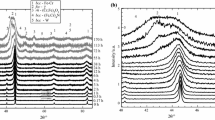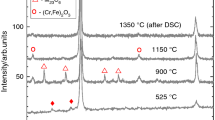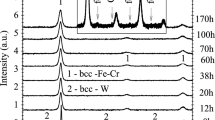Abstract
The contamination from the air (the identification of the impurity phases and their thermal evolution) of Fe–14Cr–3W–0.4Ti–0.25Y2O3 oxide dispersion-strengthened ferritic steel powders ball-milled for different times was evidenced by thermal analysis in correlation with X-ray diffraction and scanning electron microscopy. The powders loaded under an argon atmosphere and milled up to 170 h with and without interruption of the milling process were compared. A steady state of Fe–Cr alloying was reached within the first 12 h. The reflections corresponding to a new phase with an fcc-CrN structure were found in XRD patterns of powders milled for a long time with interruption. The differential thermal analysis of powders milled over 12 h with interruption shows an exothermic peak at 625.5–653 °C, ascribed to the coarsening of the fcc-CrN, and an endothermic reaction above 1000 °C accompanied by a mass loss in thermogravimetric analysis. (Cr,Fe)2O3 and retained austenite were also found upon the heating of as-milled (with interruption) powders to different temperatures. The endothermic feature was associated with the decomposition of CrN accompanied by the degassing of N2. The observed phenomenon was explained to be the manifestation of contamination with nitrogen and oxygen from the air during the milling; the rate of contamination with nitrogen was estimated to be 0.011 mass% h−1. The contamination level depends on the degree of alloying at the moment of the interruption of milling process. The contamination of the powders milled without interruption of milling process was insignificant. The experimental conditions described in this work can be further developed for the removal of impurities (e.g. nitrogen, nitrides, oxides) from alloyed ferritic steel powders.









Similar content being viewed by others
References
Baluc N, Boutard JL, Dudarev SL, Rieth M, Correia JB, Fournier B, Henry J, Legendre F, Leguey T, Lewandowska M, Lindau R, Marquis E, Muñoz A, Radiguet B, Oksiuta Z. Review on the EFDA work programme on nano-structured ODS RAF steels. J Nucl Mater. 2011;417:149–53.
Stork D, Agostini P, Boutard JL, Buckthorpe D, Diegele E, Dudarev SL, English C, Federici G, Gilbert MR, Gonzalez S, Ibarra A, Linsmeier C, Puma AL, Marbach G, Morris PF, Packer LW, Raj B, Rieth M, Tran MQ, Ward DJ, Zinkle SJ. Developing structural, high-heat flux and plasma facing materials for a near-term DEMO fusion power plant: the EU assessment. J Nucl Mater. 2014;455:277–91.
Suryanarayana C. Mechanical alloying and milling. New York: Marcel Dekker; 2004.
Fetch HJ. Nanostructure formation by mechanical attrition. Nanostruct Mater. 1995;6:33–42.
Cisneros MM, López HF, Mancha H, Vazquez D, Valdes E, Mendoza G, Mendez M. Development of austenitic nanostructures in high-nitrogen steel powders processed by mechanical alloying. Metall Mater Trans A. 2002;33A:2139–44.
Miller MK, Hoelzer DT, Kenik EA, Russell KF. Stability of ferritic MA/ODS alloys at high temperatures. Intermetallics. 2005;13:387–92.
Brocq M, Radiguet B, Poissonnet S, Cuvilly F, Pareige P, Legendre F. Nanoscale characterization and formation mechanism of nanoclusters in an ODS steel elaborated by reactive-inspired ball-milling and annealing. J Nucl Mater. 2011;409:80–5.
Muramatsu Y, Wanikawa S, Ohtaguchi M, Okada H, Abe F. Gas contamination due to milling atmospheres of mechanical alloying and its effect on impact strength. Mater Trans. 2005;46(3):681–6.
Azzaza S, Alleg S, Sunol JJ. Microstructure characterization and thermal stability of the ball milled iron powders. J Therm Anal Calorim. 2015;119(2):1037–46.
Mhadhbi M, Khitouni M, Azabou M, Kolsi AW. Characterization of Al and Fe nanosized powders synthesized by high energy mechanical milling. Mater Charact. 2008;59:944–50.
Hebda M, Gądek SZ, Kazior J. Thermal characteristics and analysis of pyrolysis effects during the mechanical alloying process of Astaloy CrM powders. J Therm Anal Calorim. 2012;108(2):453–60.
Danninger H, Pöttschcher R, Bradac S, Salak A, Seykammer J. Comparison of Mn, Cr and Mo alloyed sintered steels prepared from elemental powders. Powder Metall. 2005;48:23–32.
Hryha E, Dudrova E, Nyborg L. Critical aspects of alloying of sintered steels with manganese. Metall Mater Trans A. 2010;41A:2880–97.
Chasoglou D, Hryha E, Nyborg L. Effect of process parameters on surface oxides on chromium-alloyed steel powder during sintering. Mater Chem Phys. 2013;138(138):405–15.
Hryha E, Nyborg L. Oxide transformation in Cr–Mn–prealloyed sintered steels: thermodynamic and kinetic aspects. Metall Mater Trans A. 2014;45:1736–47.
Brust S. Transformation of surface oxides during vacuum heat treatment of a powder metallurgical hot work tool steel. Diploma work 2013.
Hryha E, Nyborg L. Thermogravimetry study of the effectiveness of different reducing agents during sintering of Cr-prealloyed PM steels. J Therm Anal Calorim. 2014;118:825–34.
HrubovIáková M, Dudrová E, Hryha E, Kabátová M, Harvanová J. Parameters controlling the oxide reduction during sintering of chromium prealloyed steel. Hindawi Publishing Corporation Advances in Materials Science and Engineering 2013. Article ID 789373, 16 pp.
Danninger H, Gierl C, Kremel S, Leitner G, Jaenicke-Roessler K, Yu Y. Degassing and deoxidation processes during sintering of unalloyed and alloyed PM steels. Powder Metall Progress. 2002;2(3):125–40.
Rawers JC, Maurice D. Understanding mechanical infusion of nitrogen into iron powders. Acta Metall Mater. 1995;43(11):4101–7.
Alleg S, Souilah S, Suñol JJ. Thermal stability of the nanostructured powder mixtures prepared by mechanical alloying. In: Elkordy AA, editor. Applications of calorimetry in a wide context—differential scanning calorimetry, isothermal titration calorimetry and microcalorimetry. Vienna: InTech Publisher; 2013. p. 21–48.
Hebda M, Gądek S, Skałon M, Kazior J. Effect of mechanical alloying and annealing on the sintering behaviour of AstaloyCrL powders with SiC and carbon addition. J Therm Anal Calorim. 2013;113:395–403.
Mayrhofer PH, Mitterer C, Hultman L, Clemens H. Microstructural design of hard coatings. Prog Mater Sci. 2006;51:1032–114.
Fnidiki A, Lemoine C, Teillet J. Structural and magnetic properties of grain boundaries in Fe60Cr40 alloy synthesized by mechanical alloying. J Phys Condens Matter. 2002;14:7221–32.
Hosmani SS, Kuppusami P, Goyal RK. An introduction to surface alloying of metals. (Springer Briefs in Applied Sciences and Technology. Manufacturing and Surface Engineering). Aveiro: Joao Paulo Davim, editor; 2014.
Ernst W, Neidhardt J, Willmann H, Sartory B, Mayrhofer PH, Mitterer C. Thermal decomposition routes of CrN hard coatings synthesized by reactive arc evaporation and magnetron sputtering. Thin Solid Films. 2008;517:568–74.
Mayrhofer PH, Rovere F, Moser M, Strondl C, Tietema R. Thermally induced transitions of CrN thin films. Scripta Mater. 2007;57:249–52.
Willmann H, Mayrhofer PH, Persson POA, Reiter AE, Hultman L, Mitterer C. Thermal stability of Al–Cr–N hard coatings. Scripta Mater. 2006;54:1847–51.
Salahinejad E, Aminia R, Ghaffaric M, Hadianfarda MJ. Crystal interstitial sites contribution to nitrogen supersaturation in mechanically alloyed Fe–Cr–Mn–N alloys. J Alloy Compd. 2010;505:584–7.
Amini R, Salahinejad E, Hadianfard MJ, Bajestani EA, Sharifzadeh M. A novel approach to quantify nitrogen distribution in nanocrystalline-amorphous alloys. J Alloy Compd. 2011;509:2248–51.
Acknowledgements
This work was supported by the European Community in the framework of the European Fusion Development Agreement (EFDA) under project WP13-MAT-01-ODSFS-01. The Ministry of Education of Romania (MEdC) is acknowledged for the use of the facilities of National Institute of Materials Physics under the (Nucleu) project PN09-450103. I. Pasuk, I. Mercioniu and G. Aldica are greatly acknowledged for their help in the experimental and technical support.
Author information
Authors and Affiliations
Corresponding author
Rights and permissions
About this article
Cite this article
Mihalache, V. Thermal analysis of ball-milled Fe–14Cr–3W–0.4Ti–0.25Y2O3 ferritic steel powder. J Therm Anal Calorim 124, 1179–1192 (2016). https://doi.org/10.1007/s10973-016-5304-2
Received:
Accepted:
Published:
Issue Date:
DOI: https://doi.org/10.1007/s10973-016-5304-2




